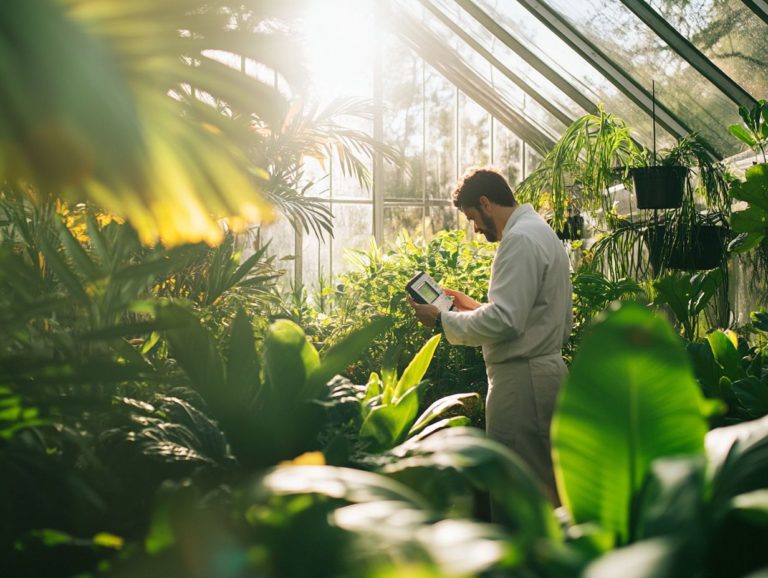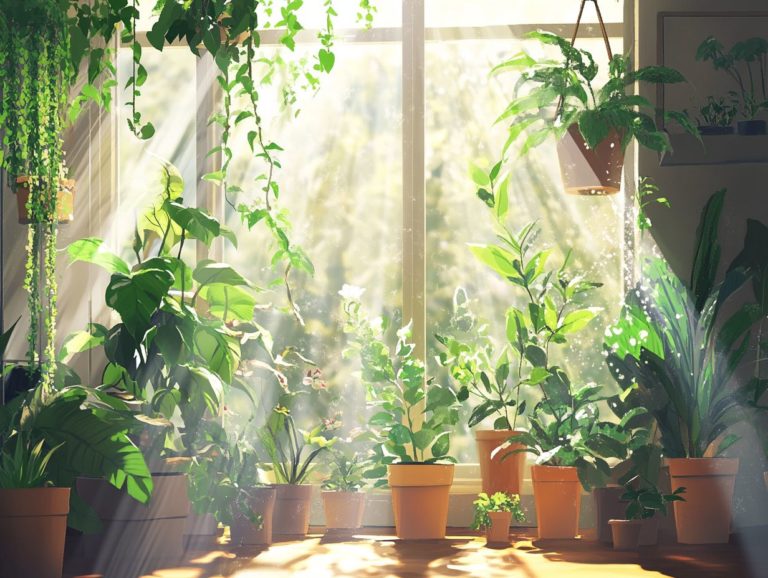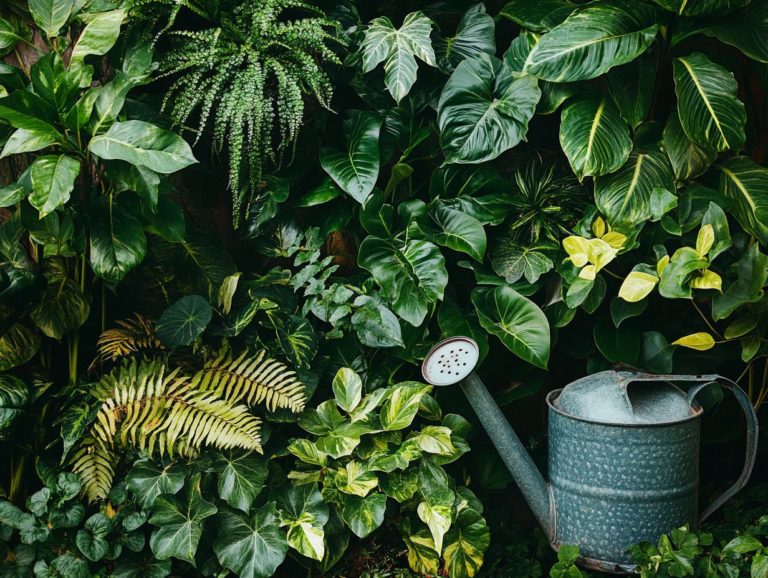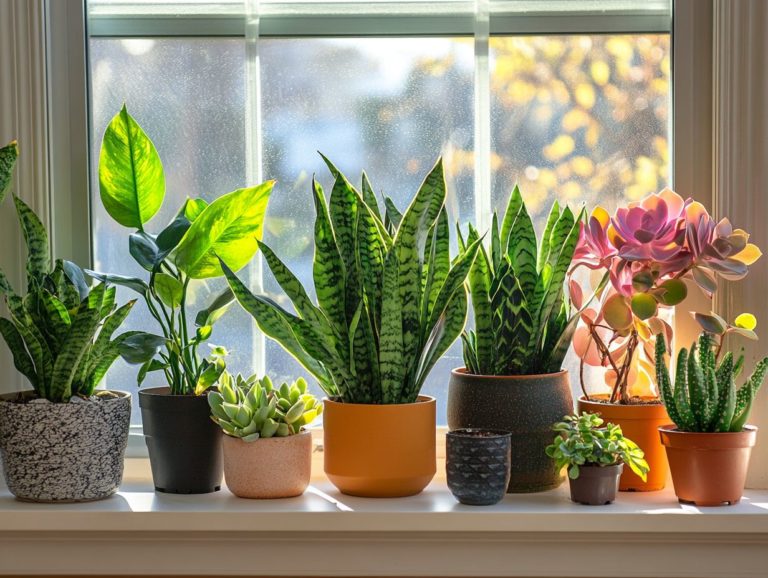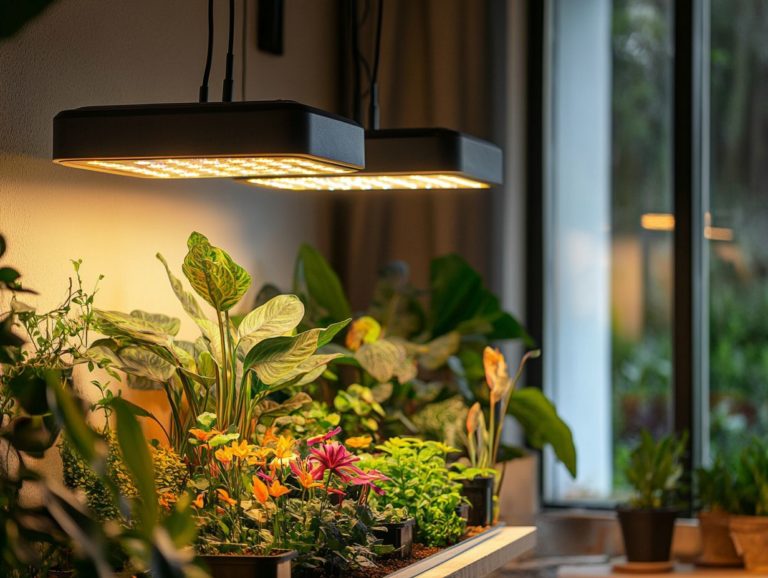How to Manage Light for Tropical Plants
Tropical plants flourish in their native habitats, enjoying ample sunlight. Understanding light is key for anyone aspiring to cultivate these exquisite species.
This article delves into the various types of light both natural and artificial and examines factors that affect light intensity, including location, season, and the different stages of plant growth.
You’ll learn how to evaluate the specific light requirements of various tropical plants. Discover strategies for optimal light management and tackle common light-related challenges, ensuring effective plant maintenance.
Join us now to discover the best practices for nurturing your tropical garden!
Contents
- Key Takeaways:
- The Importance of Light for Tropical Plants
- Types of Light for Tropical Plants
- Factors Affecting Light Intensity
- Assessing Light Needs for Different Tropical Plants
- Mastering Light for Thriving Tropical Plants
- Common Light-related Problems and Solutions
- Frequently Asked Questions
- What is the ideal amount of light for tropical plants?
- How can I tell if my tropical plant is receiving enough light?
- Do tropical plants need a specific type of light?
- How often should I rotate my tropical plants to ensure they receive enough light?
- Can I use artificial light to supplement natural light for my tropical plants?
- What should I do if my tropical plant is not receiving enough light?
Key Takeaways:
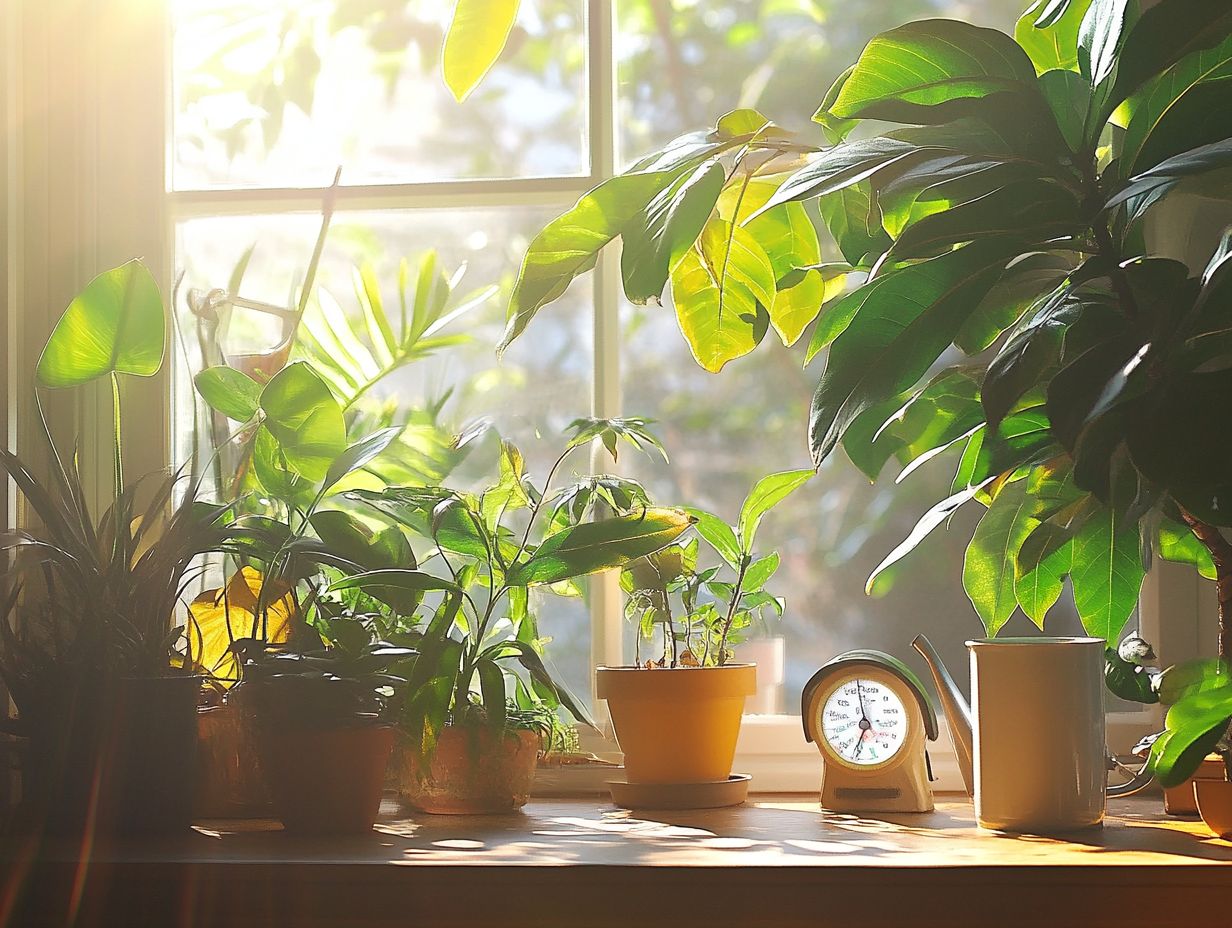
- Understanding light is key for tropical plants’ optimal growth and health.
- Natural and artificial light can provide the necessary intensity for tropical plants.
- Properly assessing light needs for different tropical plant varieties can lead to successful growth.
The Importance of Light for Tropical Plants
Light is essential for the growth and upkeep of tropical plants; it s crucial for photosynthesis, the process that turns light into chemical energy. Getting the right light spectrum, intensity, and duration is vital for different tropical plants, from succulents and cacti to orchids, allowing them to flourish in your indoor spaces.
By understanding the details about light quality and recognizing how ambient light affects your plants, you can optimize their light conditions. This ensures vibrant growth even in tricky dark corners or compact areas, perfectly aligning with effective light management.
Why Light is Essential for Tropical Plants
Light directly influences your tropical plants’ ability to perform photosynthesis the process that transforms light energy into the chemical energy needed for growth.
This intricate relationship highlights the importance of specific light spectrums, particularly red and blue wavelengths, in optimizing photosynthetic efficiency and encouraging robust plant development. Pairing adequate light with sufficient carbon dioxide levels boosts how well photosynthesis works, allowing your plants to thrive.
Different qualities of light not only affect chlorophyll production but also shape flowering and fruiting patterns, playing a pivotal role in the overall health of your plants. Understanding these dynamics is crucial as you aim to create the ideal growing conditions for various tropical flora.
Types of Light for Tropical Plants
Tropical plants flourish under a range of lighting solutions. Whether it s the warmth of natural sunlight or the precision of artificial light sources like grow lights, LED lights, incandescent lights, or fluorescent lights, each option provides distinct benefits for optimal plant care.
Natural vs. Artificial Light
Natural light, sourced from the sun, offers a full spectrum of wavelengths crucial for photosynthesis. On the other hand, artificial light provides a customizable solution for caring for your indoor plants, especially in spaces where sunlight is scarce.
Relying on natural light fosters robust growth across various plant species and enhances the vibrancy of your indoor ambiance. However, depending solely on it can pose challenges during shorter daylight months or in rooms with limited window exposure. To optimize your plant care, consider the best light arrangements for houseplants. Artificial lighting provides the flexibility you need, allowing you to cater to specific plant requirements with a variety of bulbs for different growth stages.
For example, you can use LED grow lights for light-hungry tropical plants, while fluorescent lights may be adequate for low-light species. Understanding each plant’s unique needs, including lighting considerations for plant growth, can significantly elevate their growth and health, helping you cultivate the ultimate indoor garden environment.
Factors Affecting Light Intensity
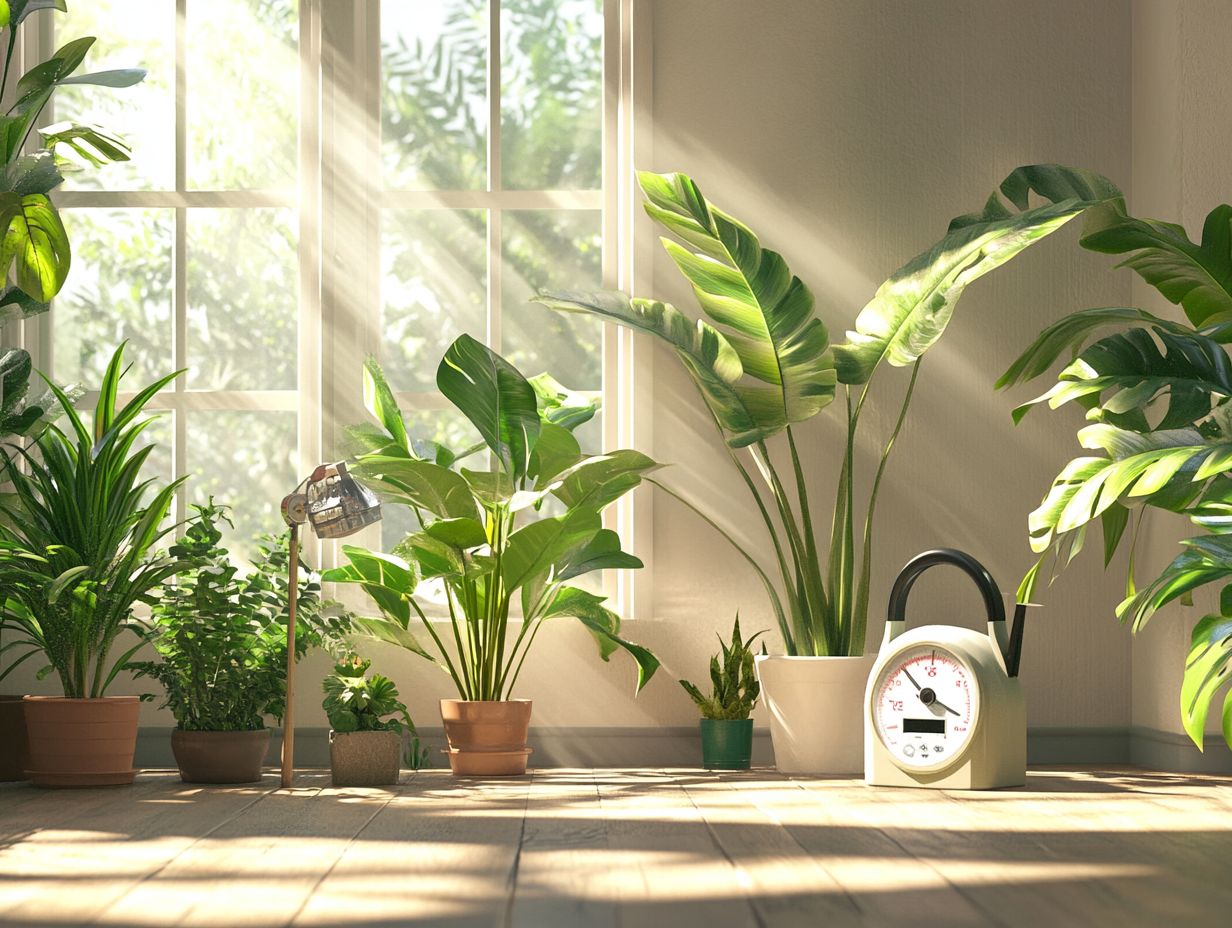
Light intensity is shaped by numerous factors. These include the placement of your plants within your home, the ebb and flow of seasonal changes, and the distinct growth stage of each plant, all of which influence their light absorption.
Therefore, a thoughtful assessment and adjustment of light settings is essential to ensure optimal lighting conditions for your plants.
Location, Season, and Plant Growth Stage
The location of your tropical plants, the shifting seasons, and their growth stages all play a vital role in the light intensity they receive. It s crucial to monitor and adjust their light exposure as needed.
Consider this: a plant by a south-facing window may soak up bright light in summer but find itself in the shadows come winter. During their early growth phase, many tropical species thrive in bright, indirect light. However, as they mature, their light requirements often evolve, demanding more direct sunlight.
To navigate these fluctuations effectively, use light meters or handy smartphone apps to measure light levels. Regularly assess the light conditions and adjust the plants’ positions or use sheer curtains for diffusion. For more detailed guidance, check out how to position plants for best light. This creates an ideal environment year-round, fostering optimal growth and vitality.
Assessing Light Needs for Different Tropical Plants
Understanding the specific light requirements of various tropical plants is essential for ensuring optimal care and growth. Each variety be it orchids, succulents, or flowering plants has unique needs that can be met with tailored lighting solutions.
By focusing on these distinct requirements, you can create an environment that encourages flourishing plants and vibrant growth, ensuring they receive the right light conditions.
Understanding Plant Varieties and Their Light Requirements
Different tropical plant varieties come with their own unique light requirements. Understanding each plant’s needs is vital for optimal growth and photosynthesis.
For instance, some tropical species flourish in bright, indirect light, while others thrive in low-light conditions. This difference significantly impacts their development and overall vitality. As a gardener, it’s crucial to identify the specific light preferences of each plant type. For effective light management, consider using light shades for indoor plants. Inadequate light exposure can lead to stunted growth or increased susceptibility to disease.
Manage light exposure by strategically placing plants near windows or using grow lights in areas lacking natural sunlight. Keep an eye on the duration and intensity of light. For indoor orchids, proper light management is crucial; too much direct sunlight can scorch delicate leaves, while insufficient light can hinder their ability to photosynthesize effectively.
Mastering Light for Thriving Tropical Plants
Effective light management is essential for the optimal growth of tropical plants. It s time to take charge and optimize your light settings for thriving plants!
Consider light optimization, settings, and selecting suitable grow light fixtures to cater to their specific needs. This ensures your plants thrive, unlocking their full potential!
Strategies for Providing Adequate Light
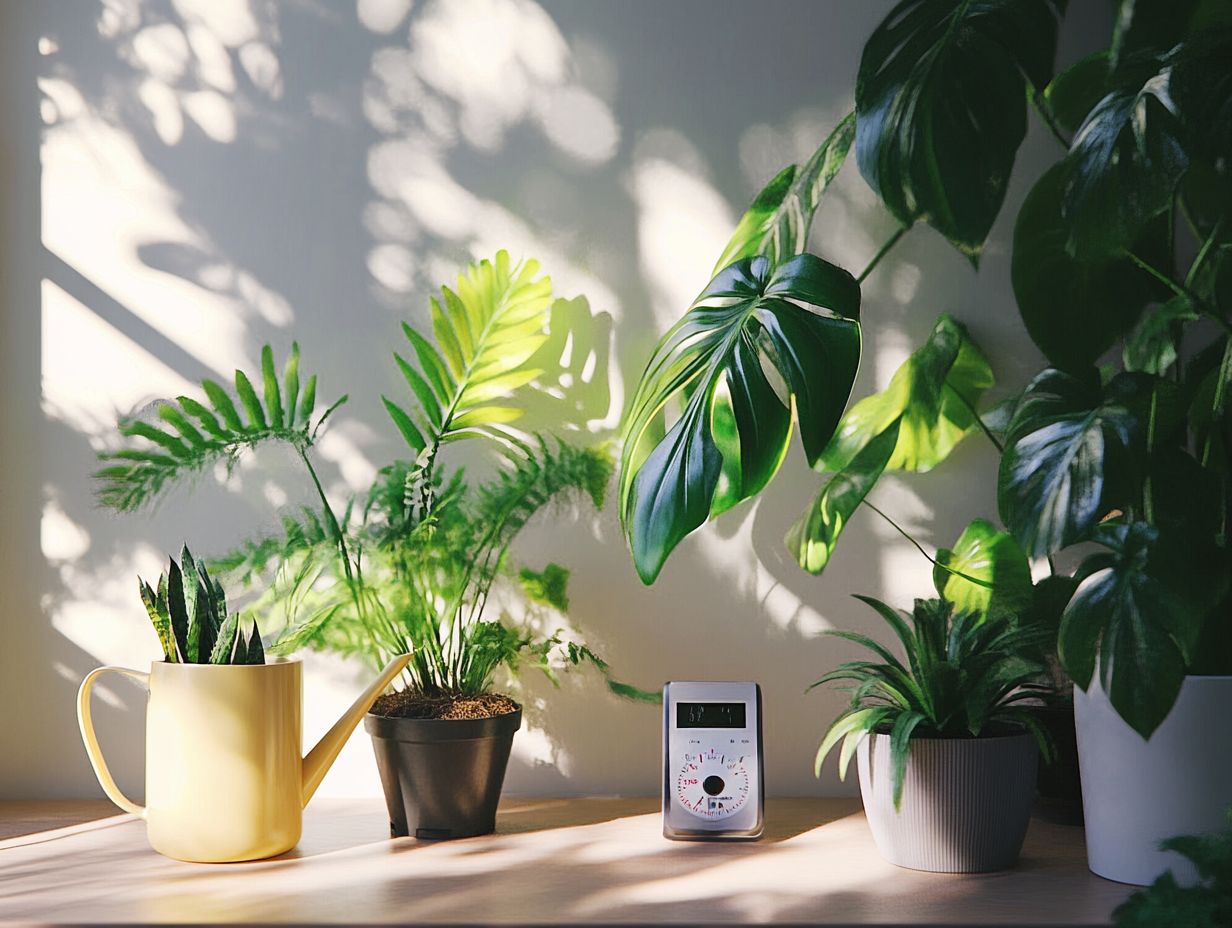
To ensure your tropical plants receive the ideal amount of light, implement effective light management strategies. This involves adjusting light sources, carefully considering their placement, and utilizing grow lights tailored to the specific needs of each plant.
By selecting the right types of light bulbs that emit the appropriate spectrum, you enhance photosynthesis and promote healthier growth. Position these light sources at suitable distances from the foliage to prevent leaf burn while maximizing light absorption.
Integrating grow lights into your setup can be invaluable, especially during seasons when natural sunlight is limited. Recognize that different plants have varying light requirements; some thrive in bright, direct light, while others prefer softer, indirect illumination. For more insights, check out understanding indoor plant light needs. Matching these light conditions to each plant’s needs will significantly boost their growth and vitality.
Common light-related issues like insufficient light strength, inadequate light duration, and poor light type can significantly impede the growth of tropical plants. Keep your plants thriving by applying these effective solutions!
To ensure the ongoing health and vitality of your plants, it’s essential to implement effective solutions that address these challenges.
Addressing Issues with Light Strength, Duration, and Type
To cultivate healthy tropical plants, you must carefully address light issues. Monitor light strength, duration, and type. Use grow lights when natural light is insufficient.
Understanding how these factors influence plant growth equips you to create an optimal environment. Use a light meter, a tool that measures light strength, to assess the current intensity, adjusting as necessary. Many tropical plants flourish in bright, indirect light.
For duration, strive for a daily light exposure of 12 to 16 hours, replicating their natural habitat. This is especially crucial during the dreary winter months.
Ensure the quality of light by selecting full-spectrum grow lights, which provide all the right colors of light that plants need to grow. Position them at the appropriate distance to prevent light burn while still providing ample exposure.
By consistently monitoring your plants responses, you can fine-tune these variables, nurturing robust growth.
Frequently Asked Questions
What is the ideal amount of light for tropical plants?
The ideal amount of light for tropical plants varies depending on the specific species. Generally, tropical plants prefer bright, indirect light. They should not be placed in direct sunlight as it can damage their leaves.
How can I tell if my tropical plant is receiving enough light?

One way to tell if your tropical plant is receiving enough light is by observing its growth. If it is growing tall and leggy, it may not be getting enough light. If it is developing yellow or brown leaves, it may be receiving too much light. You can also use a light meter to measure the amount of light your plant is receiving.
Do tropical plants need a specific type of light?
Tropical plants can benefit from a variety of light sources, including natural sunlight, fluorescent lights, and LED lights. However, it is important to choose a light source that emits the right spectrum of light for your particular tropical plant.
How often should I rotate my tropical plants to ensure they receive enough light?
Tropical plants should be rotated every few weeks to ensure even exposure to light. This is especially important if they are placed near a window, as the light intensity may vary throughout the day.
Can I use artificial light to supplement natural light for my tropical plants?
Yes, artificial light can be used to supplement natural light for tropical plants. This is especially useful during the winter months when natural light may be limited.
What should I do if my tropical plant is not receiving enough light?
If your tropical plant is not receiving enough light, you can try moving it to a brighter location or supplementing with artificial light. You can also prune back any leggy growth to encourage new growth and improve the plant’s overall health.
Experiment with these strategies today to see your tropical plants flourish!

